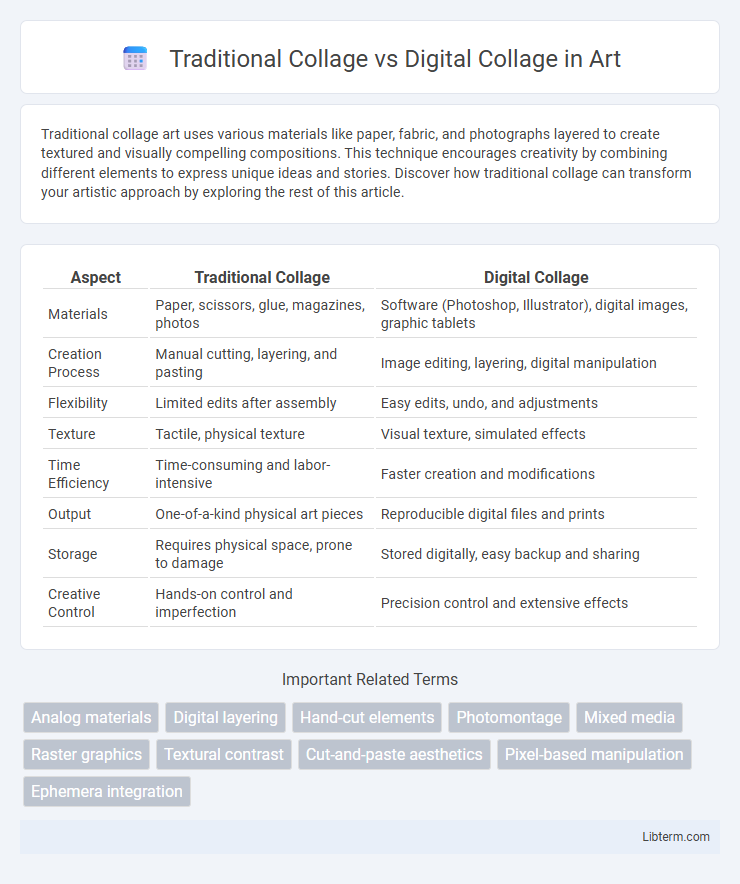Traditional collage art uses various materials like paper, fabric, and photographs layered to create textured and visually compelling compositions. This technique encourages creativity by combining different elements to express unique ideas and stories. Discover how traditional collage can transform your artistic approach by exploring the rest of this article.
Table of Comparison
| Aspect | Traditional Collage | Digital Collage |
|---|---|---|
| Materials | Paper, scissors, glue, magazines, photos | Software (Photoshop, Illustrator), digital images, graphic tablets |
| Creation Process | Manual cutting, layering, and pasting | Image editing, layering, digital manipulation |
| Flexibility | Limited edits after assembly | Easy edits, undo, and adjustments |
| Texture | Tactile, physical texture | Visual texture, simulated effects |
| Time Efficiency | Time-consuming and labor-intensive | Faster creation and modifications |
| Output | One-of-a-kind physical art pieces | Reproducible digital files and prints |
| Storage | Requires physical space, prone to damage | Stored digitally, easy backup and sharing |
| Creative Control | Hands-on control and imperfection | Precision control and extensive effects |
Introduction to Collage Art
Collage art combines various materials such as paper, photographs, and fabric into a cohesive visual composition. Traditional collage relies on physical materials and manual techniques like cutting, pasting, and layering, emphasizing tactile textures and imperfections. Digital collage uses software tools for seamless integration, enabling enhanced manipulation, scalability, and easier modification of images.
Defining Traditional Collage
Traditional collage involves assembling physical materials such as paper, fabric, photographs, and found objects onto a surface to create a new composition. This art form emphasizes tactile interaction, layering textures, and manual techniques like cutting, pasting, and painting. The hands-on process of traditional collage fosters unique, tangible artworks with distinct material qualities.
What is Digital Collage?
Digital collage is an art form that combines various images, textures, and elements using digital tools and software, allowing for precise manipulation, layering, and blending. Unlike traditional collage, which relies on physical materials like paper and glue, digital collage leverages technology such as Adobe Photoshop or Procreate to create seamless and easily editable compositions. This method offers artists enhanced flexibility, unlimited editing possibilities, and the ability to integrate multimedia components in their creative process.
Tools and Materials Compared
Traditional collage uses physical materials such as paper, fabric, photographs, scissors, glue, and sometimes paint or ink, allowing for tactile layering and texture variation. Digital collage relies on software like Adobe Photoshop, Procreate, or GIMP, incorporating digital images, textures, and brushes with tools for layering, blending, and effects that enable infinite editing possibilities. The choice of tools and materials heavily influences the creative process, with traditional collage offering tangible manipulation and digital collage providing flexibility and ease of revision.
Creative Processes in Both Mediums
Traditional collage involves physically cutting and assembling materials such as paper, fabric, and photographs, which encourages tactile experimentation and spontaneous layering that can lead to unexpected textures and compositions. Digital collage utilizes software tools like Adobe Photoshop and Procreate, enabling precise control over elements, seamless blending, and easy manipulation of sizes, colors, and effects, streamlining iterative refinements. Both mediums foster creativity but differ in workflow dynamics, with traditional processes emphasizing hands-on craftsmanship and digital methods offering greater flexibility and reproducibility.
Visual Aesthetics: Analog vs Digital
Traditional collage offers a tactile visual aesthetic characterized by textured paper, layered materials, and organic imperfections that create depth and a unique handcrafted appeal. Digital collage enables precise manipulation of images, seamless blending, and vibrant color adjustments, resulting in polished and versatile compositions. Both methods deliver distinct visual experiences, with analog collages emphasizing materiality and digital collages prioritizing flexibility and clarity.
Accessibility and Flexibility
Traditional collage requires physical materials like paper, scissors, and glue, limiting accessibility due to cost and availability of supplies. Digital collage offers greater flexibility by enabling easy editing, layering, and undoing mistakes through software like Adobe Photoshop or Procreate. Accessibility is enhanced with digital tools available on multiple devices, allowing artists to create collages anytime without physical constraints.
Preservation and Longevity
Traditional collage, created using physical materials like paper, fabric, and adhesives, requires careful storage in controlled environments to prevent deterioration from factors such as light exposure, humidity, and acidity. Digital collage offers enhanced preservation and longevity by storing artwork in secure digital formats, eliminating risks of physical damage and enabling easy replication without quality loss. Archival-grade materials can extend the lifespan of traditional collages, but digital collages provide a more reliable solution for long-term preservation and accessibility.
Environmental Impact Considerations
Traditional collage involves physical materials like paper, glue, and scissors, often producing waste and requiring resource-intensive supplies. Digital collage minimizes physical waste and reduces the need for raw materials but depends on electricity and electronic devices, contributing to energy consumption and e-waste. Evaluating environmental impact requires comparing resource extraction, waste management, and carbon footprints associated with both methods.
Choosing the Right Medium for Your Art
Choosing between traditional collage and digital collage depends on the desired tactile experience and creative control. Traditional collage offers the richness of physical textures and hands-on manipulation, ideal for artists valuing organic imperfections and material depth. Digital collage provides unlimited editing flexibility, layering options, and easy reproduction, making it suitable for projects requiring precise adjustments and seamless integration.
Traditional Collage Infographic

 libterm.com
libterm.com